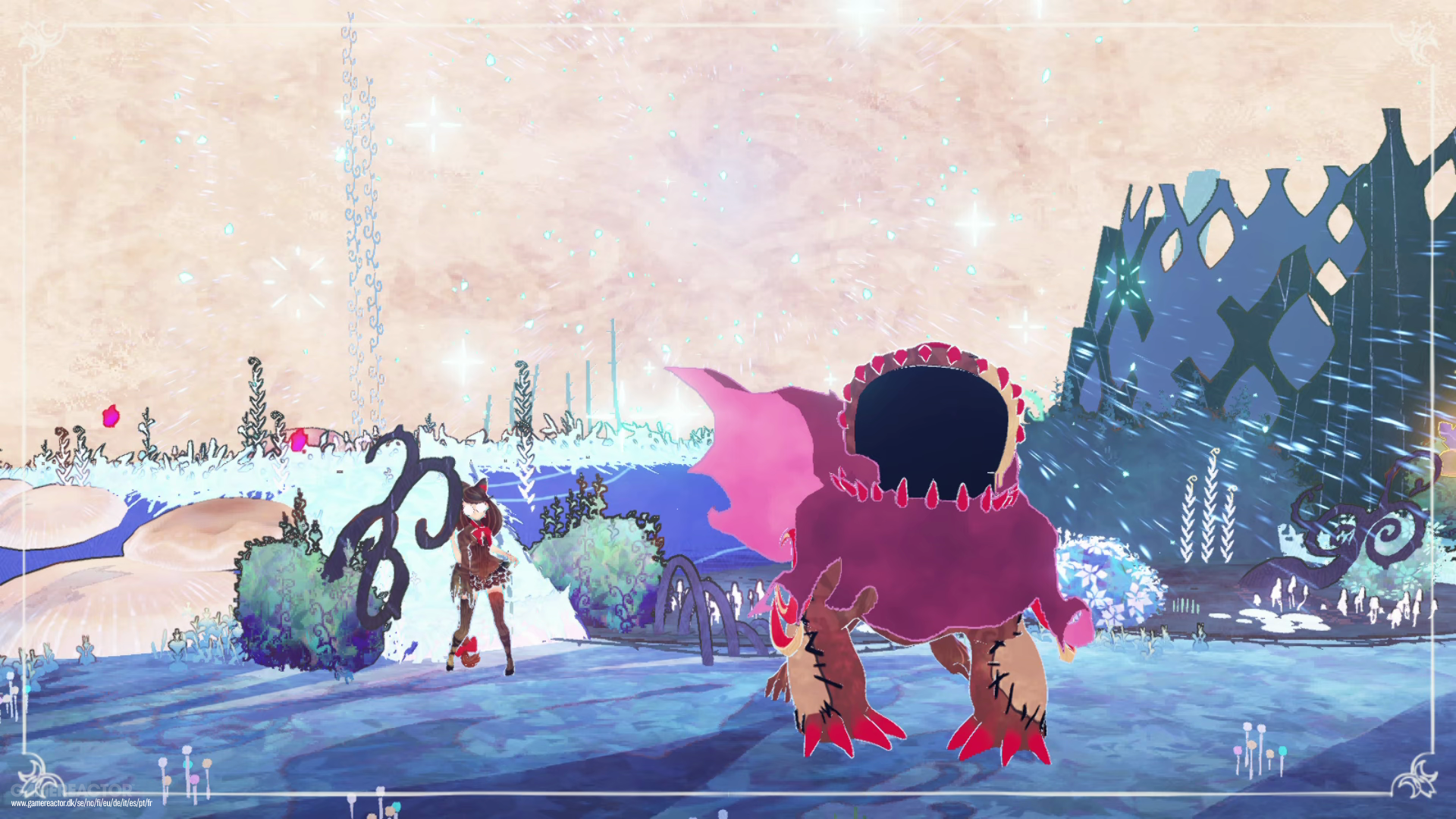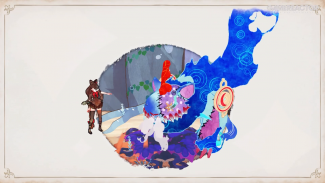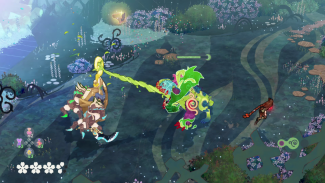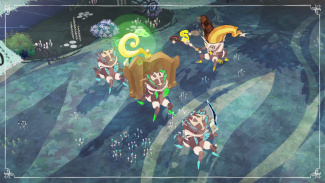You have to give PlatinumGames credit for having what it takes to create a prequel/spin-off that loads up the hallmarks of the original games in such a drastic way. The fact that Cereza and the Lost Demon strays so far from the original Bayonetta trilogy is something we should celebrate, because that’s precisely the kind of risk to ask for in these spin-off works: something that gives fans a completely new perspective on the saga, but which retains its fundamental essence.
Despite the fact that I myself admitted two weeks ago that this story begins so slowly that I almost fell asleep, now I can assure you that I enjoyed almost the whole adventure, since its systems and the progression of the game’s dynamics managed to capture my attention, as did its watercolor art style from the start.
In all honesty, from the outside, Bayonetta Origins: Cereza and the Lost Demon might seem like a simpler, cheaper attempt to adapt Triple A hack and slash games in the worst possible way. At first, it features weird, almost stilted two-stick controls: the top-left stick and buttons control Cherry and their right-hand counterparts in Cheshire the Demon (now familiar to those who’ve played Bayonetta 3 recently). Cheshire is the first summon that comes to the 10-year-old apprentice witch and accompanies her as she learns the customs of Umbra under Morgana’s strict supervision in the Avalon Forest.
Advertisement:
Without any hint of the intricate cinematic combat or popcorn sequences that characterize the original series, the move to a quieter, more exploration-based Metroidvania experience had to work perfectly to win in the long run. However, it takes about 4-5 hours to get there, no matter how beautiful the pages of this story are (the voice in English, too bad, but the texts are beautifully translated into Spanish). Luckily, once you get used to the different mechanics and find more challenges and new skills, the game routine becomes fun and even quite unique, compared to other games of the same genre.
In other words, to be completely clear, many might dismiss this game as any indie metroidvania, nothing special among PlatinumGames games. However, as I turned the pages, and even more after closing the story, it left me with the feeling that I could compare it to games like Ori and the Blind Forest: it’s charming and , sometimes, even memorable, even if it is not able to stand out within this new genre.
As you might have guessed already with the references to Avalon and Morgana, Cherry’s Tale presents a different take on the King Arthur mythos, much as the main series does with the eternal fight between angels and demons, deities, Creators, etc. I won’t reveal anything about what happens in the game, but I will say that it manages to work as an origin story to learn more about the witch character we all know and love. It naturally opts for a more direct story, as opposed to the time jumps and convoluted storylines of the original trilogy. That being said, the game has several nice twists up its sleeve and I enjoyed the differences and clash of Cherry and Cheshire’s egos. Speaking of twists, this game’s fairytale performance is one of the most compelling and twisted I’ve ever seen.
Advertisement:
The Avalon forest generates a great feeling of change of scenery and, as you go deeper into it, you feel more and more lost and hunted. It’s good and bad at the same time, as the map seems deliberately drawn in an unclear, somewhat confusing way (especially when it comes to otherwise decent verticality), to get you to personally explore every nook and cranny of the natural and organic environment in search of secrets, treasures and improvements. Cherry Spells and Cheshire Powers break new ground and can sometimes be used in tandem in platforming sections. This combination generally works, except for a few minor detection bugs (which also showed up in combat).
In my experience, exploration is pretty good as long as you stick to the main path and take the most obvious detours, but it can feel a bit unfair or even boring when you want to complete the entire game before and after the generic. . In these cases, the game forces you to take long, old-fashioned walks, rather than making it easier and faster with shortcuts (despite the fast travel option that opens mid-game) .
However, the level design is very good overall and the same could be said for most of the puzzles. So much so that I wish more of Tír na nÓg (the enchanted phases you have to solve to clear the map) focused on puzzles rather than combat, as some left me with the best aftertaste of Zelda, but with that game’s special two-lever focus.
Most of these areas are combat-oriented. Although it starts off as slowly as every other mechanic, the combat system ends up being diverse and entertaining in the long run, both in the Tír na nÓg and in the many sudden encounters that take place in the forest. If you are looking for quick reflexes and being able to quickly move your character around the stage to beat giant creatures, it is better to go back to the original trilogy, because in this one you will have to gradually learn to keep an eye on the girl and another on the demon, literally. With the witch you cast spells on enemies (mostly to bind them with zip ties) and use potions, and with the demon you deal damage to them using their vicious bites and claws, or choosing attacks and appropriate basic abilities.
As the game progresses, Cherry and Cheshire grow stronger with a nice skill tree that grows more branches. The bond between the characters makes their combination really powerful. As much as we love Cherry (and this 10-year-old remake that this installment presents us with), Cheshire is a sensation in both story and gameplay. Her movement and the incredible elemental powers and various transformations of this grumpy plush cat with precarious seams are fantastic. It will be difficult for you to choose your favorite Cheshire among its Vegetable, Stone, Water and Fire forms.
In the end, I finished over 80% of the game after about 20 hours, having spent a few hours trying to finish it (unsuccessfully) before the final battles. Which, by the way, are very good and to some extent ingenious. Also, there is a lot of fanservice towards the end for Bayonetta fans, not only in the story but also in the gameplay. We must also add that this title is not difficult at all for a fan of the series or the action genre until the last pages of the story, and that it presents very good accessibility options to facilitate the task. to apprentices. And although I insist that it’s not the best game for finalists and I wanted to quit it as soon as I finished it, after all it’s a metroidvania and now I’ve almost finished it in its entirety (I can’t help myself).
In the end, what seemed like a rather ordinary, slow-paced indie metroidvania ended up mesmerizing me by combining a spooky fairy tale with some original ideas, all wrapped up in a splendid visual finish. This original concept makes for a very personal origin story for Team Lost Faeries, despite their different sources of inspiration (and I haven’t even mentioned their own Okami). It’s a story worth playing on its own merits.





